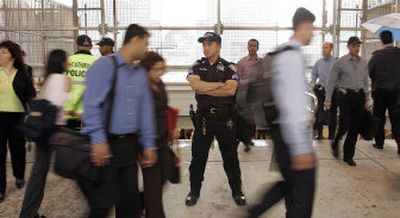High alert on transit systems may be lowered soon

WASHINGTON – The nation’s transit systems could be on high alert for just a few days as a precaution against copycat attacks following the London bombings, U.S. counterterror officials said Friday.
Barring any new intelligence from the London investigations or elsewhere, the Homeland Security Department could lower the threat level from orange, or high risk, back to yellow, or elevated, as early as next week, three officials said.
The officials cautioned, however, that it could take weeks for Homeland Security and other counterterror officials to feel confident that there was no immediate risk of a follow-up attack in the United States to the subway and bus bombings in London. Coordinated copycat attacks generally occur within two weeks of initial strike.
Threat levels were elevated to orange for more than three months last year at financial institutions in Washington, New York and New Jersey.
The officials all spoke on condition of anonymity because they were basing their remarks on classified information.
Targeted to rail, subway and bus systems, the threat alert was raised despite a lack of any specific evidence of an impending domestic attack. However, recently acquired intelligence dating to the March 2004 Madrid bombings indicated al Qaeda’s interest in attacking rail systems in Europe and the United States.
The Homeland Security Department, along with White House and intelligence advisers, will assess whether to lower the threat level early next week, one official said.
Officials raised the alert this week to orange – the second-highest level – for a seventh time since the five-color system was created in 2002.
Homeland Security Secretary Michael Chertoff is considering overhauling the system. Critics, including House Homeland Security Committee Chairman Christopher Cox, R-Calif., have proposed making the color system optional, saying it is too vague and ultimately confuses the public.
Raising the alert level can incur hundreds of millions of dollars in overtime and equipment costs to state and local police agencies and other first responders. Some of those costs are reimbursed by a first responders fund managed by the Homeland Security Department, for which President Bush has requested $2.6 billion for next year.
But transit authorities expect to receive less than $135 million in federal reimbursements while the alert remains at code orange – not enough to maintain security costs for very long.
“If we do have a continuation of this state, we will indeed be needing further funding to be provided,” said Greg Hull, security chief for the American Public Transportation Association.
“We don’t necessarily have the levels of staffing to sustain, and if we find we have to stay at orange for a number of months, we have to look at hiring additional staff,” he said.
The association is in charge of coordinating security issues between Homeland Security and public transportation authorities.
Still, raising threat levels within a specific industry or region – such as with the current transit system alert or at the financial institutions during last year’s election season – is far cheaper than doing so nationwide.
Virginia state Homeland Security Director George Foresman said he expects Chertoff to resist future nationwide threat alerts as part of his changes to the system.
“I don’t think he’s ready to throw out the baby with the bath water, but I think he’s realized that the baby’s grown a little bit,” Foresman said.
Thursday’s alert “was a very surgical threat action,” said Foresman, who was briefed before the alert was raised. “It was very precise, and I think a lot of people will appreciate it.”
The risk level is rarely raised or lowered based on specific threat information, but instead on a “gut check, quite frankly,” said John Rollins, a former Homeland Security intelligence official.
The risk level changes are based on a mix of intelligence, the target’s vulnerability and consequences of an attack, said Rollins, now a terrorism expert at Congressional Research Service. “And part is based on prudence if the intelligence is not there, which it’s not at the present,” Rollins said. “At the end of the day it’s ‘make your best estimate.’ “